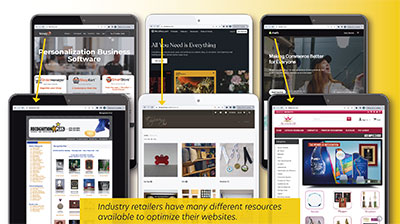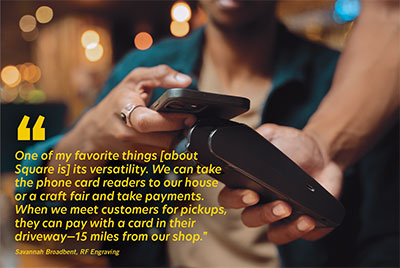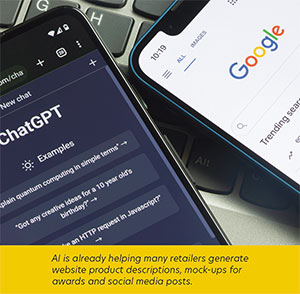In-person customer service and relationship-building have been the backbone of the personalization industry for decades—something not likely to change any time soon. Across the board, though, digital tools are helping personalization shops increase sales, find new customers, manage employees and a whole lot more.
Tool Party
The digital tools that are—and aren’t—helping retailers right now.
By: Jason Henninger
(Originally printed in the November/December 2023 issue of Insights.)
In-person customer service and relationship-building have been the backbone of the personalization industry for decades—something not likely to change any time soon. Across the board, though, digital tools are helping personalization shops increase sales, find new customers, manage employees and a whole lot more.
However, it can be difficult to track new apps and online resources, especially as technology evolves at an ever-accelerating rate. So what tools are most useful? And how do you maintain great customer relationships at a distance? To start, it can be helpful to view the various tools through the lens of the following three categories:
- Digital marketplaces: venues for sales other than your physical storefront. These could include your company website, Etsy, Facebook Marketplace and wherever else you may sell.
- Payments: ways to receive payment beyond typical cash or credit card readers, which include in-person options like ApplePay and Square, or methods such as Zelle, Venmo and Paypal.
- Marketing: This broad category includes everything from advertising via Google Ads, using text or email-based marketing platforms such as MailChimp or SubText, or services that help you create a homepage and virtual shopping cart.
Naturally, these three categories can overlap; a website creation service may include options for adding payment methods and advertising, for instance. With so many tools to help your business grow, industry retailers share what has—and hasn’t—worked for them.
Online Marketplaces
The digital marketplace abounds, with more online businesses than ever. When Etsy launched, for instance, it focused on crafts, whether from hobbyists or professionals. While artists still make up an important part of the site, Etsy has since grown to be a digital storefront for all manner of retailers. Consider that retailers on Etsy sold $3 billion in goods in the first quarter of 2023 alone, with more than 37% of buyers being repeat customers, according to Marketplace Pulse.
Similarly, eBay began with an audience of collectors but developed into a place where buyers could find just about anything. In general, these sites, including Facebook Marketplace, have shifted from simply being a place for peer-to-peer selling to becoming a legitimate way for businesses to earn money and find new customers.
Amanda Gianotti, President of Allogram in Maryland, joined her family business in 1988 and now owns two locations and employs more than 20 people. She’s had an Etsy page for years. “It’s not anything huge,” Gianotti says. “But we keep it. It’s very inexpensive to sell on Etsy. The fees are extremely low. I think last month, my fee was 40 cents. So, it’s pretty cheap. Keep in mind, we’re not selling too much, but it’s out there, and people do sometimes find us that way.”
 That being said, these marketplaces might not be the right investment for every business, as fees and labor can be a sticking point. For instance, Greg Azorsky, owner of Recognition Plus in Independence, Missouri, uses Shopify for side projects, but his primary shop’s products are listed on the company’s website. He’s been in the industry since 2004 and is also on APA's board. Azorsky doesn’t feel it would be profitable to run his full storefront via Etsy, considering the labor involved with listing items and the fees that Etsy charges. “I don’t think I would want to be using Etsy for what we’re doing every day,” he says.
That being said, these marketplaces might not be the right investment for every business, as fees and labor can be a sticking point. For instance, Greg Azorsky, owner of Recognition Plus in Independence, Missouri, uses Shopify for side projects, but his primary shop’s products are listed on the company’s website. He’s been in the industry since 2004 and is also on APA's board. Azorsky doesn’t feel it would be profitable to run his full storefront via Etsy, considering the labor involved with listing items and the fees that Etsy charges. “I don’t think I would want to be using Etsy for what we’re doing every day,” he says.
Other limitations exist on these platforms, as well. Savanna Broadbent and her husband have run RF Engraving in Utah since 2015, taking over for her parents, who opened the shop about seven years earlier. Personalization is one of two jobs they have; she is also a school principal, and he is a middle school teacher. Broadbent is not a big fan of Etsy. “We have found ourselves correcting a lot of engravings ordered through Etsy. It has made business more difficult because many on Etsy are not concerned with copyrights, so we are frequently asked why a person can purchase an infringement item online, but we can’t make it for them in-shop,” she says.
Company Websites as Marketplaces
While digital marketplaces might not be for every business, having a good website is almost always a must these days—for both marketing and sales purposes.
Azorsky uses NetSoft’s BizWizard, a website-building platform designed for the industry. “They take care of importing all of the items from our suppliers—catalogs and things like that,” Azorsky says. BizWizard offers a shopping cart feature and order manager that Azorsky finds particularly useful.
 Broadbent's website was designed with WordPress, arguably the most well-known and widely used website builder. Her site focuses on demonstrations and a small sample of products they offer. “We have found it very helpful,” she says, “as we have a particular plaque that is ideal for online ordering. That makes it easier for customers.”
Broadbent's website was designed with WordPress, arguably the most well-known and widely used website builder. Her site focuses on demonstrations and a small sample of products they offer. “We have found it very helpful,” she says, “as we have a particular plaque that is ideal for online ordering. That makes it easier for customers.”
Gianotti is developing a new website with Shopify, a commerce-oriented website platform. She says the way her site is used has changed over time, which, in addition to her old site being slow and cumbersome, is among the reasons she’s switching to Shopify. “We have always used it as an educational tool,” Gianotti says of her website. “When we have someone on the phone, we direct them to the website.”
However, COVID shifted the business’ interactions with customers. “All of a sudden, we started getting orders through the website and making revenue,” Gianotti says. “The website became much more active, which has forced us to upgrade.”
Shopify is helping Gianotti pivot to having a more commercially focused site. Among Shopify’s perks, Gianotti says, are its numerous templates and that it’s generally user-friendly, which is important for a company without a dedicated IT department.
Payment Options
Like the digital marketplace environment, different payment options have vastly increased for businesses in recent years. The use of these point-of-sale (POS) systems, including Square, Shopify and Stripe, aren’t limited to processing transactions. Many of these platforms also now offer tools such as employee scheduling, customer loyalty programs and inventory tracking.
Since these POS systems have different functionalities and fees, finding the right option will be specific to your business. For instance, NerdWallet, a website that provides financial advice, lists Shopify as the best for e-commerce users, Square as the best overall POS system and Lightspeed as the best for inventory management.
Gianotti feels cash is “kind of old school” and offers a wide variety of payment methods, including PayPal and ApplePay. “You’ve got to meet the customer where they are, how they want to pay,” she says. “It’d be a heck of a thing if you had a customer who wanted to buy something but couldn’t because you didn’t take their payment method.”
Azorsky’s and Broadbent’s sites do not natively feature a payment processing function, whereas Gianotti’s upcoming Shopify site will. In terms of digital payment forms, Azorsky works mainly with Venmo for his side projects.
 Broadbent, meanwhile, has found success with Square, which has online and in-person applications. Broadbent recently switched to using Square and praises the variety and convenience it provides. The fees Square charges are completely reasonable, Broadbent says, saving the company hundreds of dollars over the past few months.
Broadbent, meanwhile, has found success with Square, which has online and in-person applications. Broadbent recently switched to using Square and praises the variety and convenience it provides. The fees Square charges are completely reasonable, Broadbent says, saving the company hundreds of dollars over the past few months.
“One of my favorite things about it is its versatility,” Broadbent says. “We can take the phone card readers to our house or a craft fair and take payments. When we meet customers for pickups, they can pay with a card in their driveway—15 miles from our shop. We also love how we can send links for customers to pay online or on their phones. This has been a game changer for our clients, some of whom are promoting their business in the remote sand dunes of central Utah. It allows us to review our invoices at any time of the month on either the kiosk or online. We would recommend it to any small business.”
Marketing Tools
As with many small businesses, shop owners in the industry wear so many hats that it can be easy to let marketing efforts slip. That’s why many retailers are now seeking out automated marketing functions.
Azorsky uses the email marketing tool OutboundEngine, which creates customized marketing packages; its basic tier includes newsletters and social media engagement, with other levels including more detailed campaigns. However, most of his business comes from established contacts, many being repeat customers. As such, marketing is not a high priority.
Shopify, meanwhile, offers customers advice on marketing, as well as packages for online ads via Google, Facebook and other sites, providing analytics to track effectiveness. Website builders and hosting platforms such as Woocommerce, BigCommerce and Oracle Netsuite all offer marketing automation capabilities, too.
A huge help for many retailers these days is the increased use of artificial intelligence (AI) for marketing purposes. AI algorithms analyze large amounts of data and make increasingly accurate predictions, providing small businesses with resources they would not likely get otherwise. With marketing, AI is already helping many retailers generate website product descriptions, mock-ups for awards and social media posts.
 By using generative AI platforms like ChatGPT, for instance, retailers can enter a few words or phrases about a product and have the free platform generate multiple paragraphs to be used as product description copy for their website. Similarly, retailers have also dabbled in prompting ChatGPT to write blog posts or social media posts on specific topics.
By using generative AI platforms like ChatGPT, for instance, retailers can enter a few words or phrases about a product and have the free platform generate multiple paragraphs to be used as product description copy for their website. Similarly, retailers have also dabbled in prompting ChatGPT to write blog posts or social media posts on specific topics.
In general, while it can be difficult to make the time to pursue marketing efforts, Gianotti says that businesses “need to be represented” online.
And for those who are reluctant about the ROI of digital efforts, Gianotti advises to look beyond just sales numbers. Sure, it might be unlikely for a Facebook user to suddenly be inspired to order a custom award, she says, but an online presence can still be useful for brand recognition and maintaining rapport with existing clients. “We need to be where people are looking.”